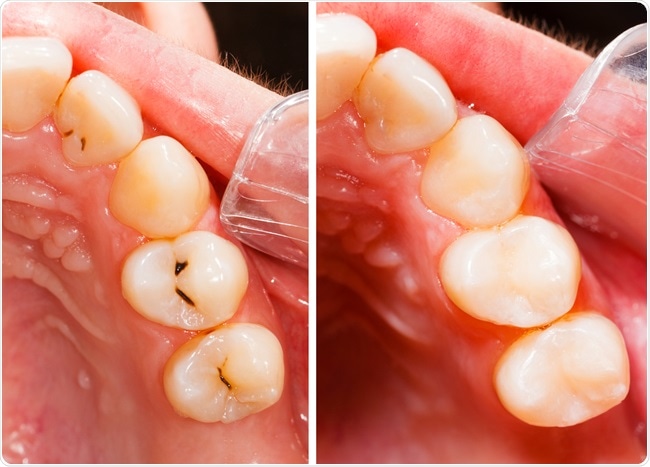The procedure for a dental filling is used to repair minor fractures or decay in the teeth, as a form of restorative dental treatment.
A dental filling can help to even out the surface of the tooth and improve the function of the jaw for biting and chewing. Many patients with tooth decay also suffer from sensitivity of the teeth due to loss of enamel, which can also be improved significantly with the placement of a dental filling.

Dental fillings. Image Credit: Alila Medical Media / Shutterstock
Consultation and Planning
The first step in the dental filling procedure is to inspect the teeth to decide upon the best course of action for the patient. A dental filling is best suited for minor fractures and decay; for more severe cases other types of restorative dental treatment, such as a dental crown or implant, may be necessary.
A dentist can examine teeth with a dental probe and caries detecting liquid to investigate problematic areas. An X-ray may also be used to determine more precise information regarding the location and severity of the decay.
There are several options of materials suitable for a dental filling to fill and seal a cavity, helping to halt any further damage to the tooth, which might result from decay. For example, the material used for the filling, such as direct composite bonding, porcelain, glass ionomer, silver amalgam or gold inlays, can vary. The appropriate choice will depend on the specific factors such as where the cavity is located and the patient’s medical history, aesthetic needs, financial availability and preference.
The Procedure
The first step in the dental filling procedure is to administer a local anesthetic so that the area around the affected tooth becomes numb, increasing the comfort of the patient throughout the procedure.
Next, the decayed or damaged tooth and its surrounding areas should be prepared for restoration. A dental hand-piece or laser may be used to remove the damaged parts of the tooth. An acid gel is used to cleanse the area to remove any remaining bacteria or debris. The filling material is then applied to the area to fill the cavity.
Dental Fillings White Amalgam 1
The placing of a composite filling requires isolation of the affected tooth; this aims to prevent any interference by allowing moisture in the bonding process in the composite restoration. For this to occur, various adhesives are placed before the composite material. The composite material can then be hardened with the use of a special bonding light.
Finally, the finished tooth can be polished to conclude the dental filling procedure.

Teeth before and after treatment - dental composite filling. Image Credit: Lighthunter / Shutterstock
Follow-Up
When the dental filling procedure is complete, it is important for the dentist to spend some time with the patient to discuss how decay can be prevented from forming underneath or near the filling. These methods will also be useful in preventing decay in other teeth.
Patients should be advised to follow good oral care practices, such as brushing their teeth with fluoride toothpaste twice daily, flossing, and using an interdental cleaner daily. Fluoride mouth rinses can also be beneficial for patients with a high risk of further decay.
Some patients with a high risk of caries may also benefit from a sealant placed over the molars at the back of the mouth to prevent plaque build-up and decay in the area.
Follow-up appointments are sometimes required to check the progress of the tooth with the filling and for regular professional cleanings.
References
Further Reading